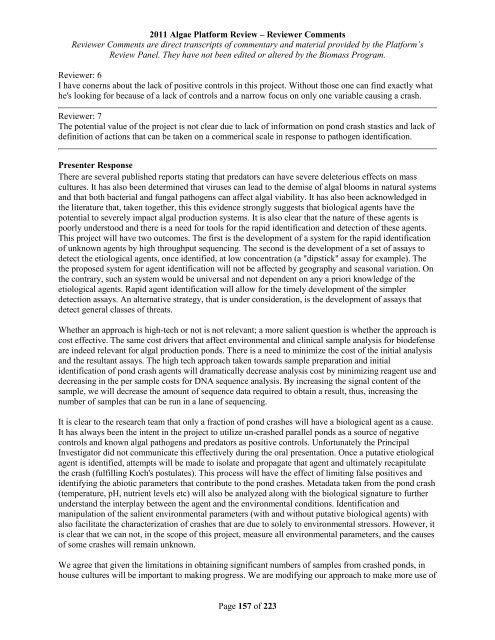Reviewer Comments - EERE
Reviewer Comments - EERE
Reviewer Comments - EERE
You also want an ePaper? Increase the reach of your titles
YUMPU automatically turns print PDFs into web optimized ePapers that Google loves.
2011 Algae Platform Review – <strong>Reviewer</strong> <strong>Comments</strong><br />
<strong>Reviewer</strong> <strong>Comments</strong> are direct transcripts of commentary and material provided by the Platform’s<br />
Review Panel. They have not been edited or altered by the Biomass Program.<br />
<strong>Reviewer</strong>: 6<br />
I have conerns about the lack of positive controls in this project. Without those one can find exactly what<br />
he's looking for because of a lack of controls and a narrow focus on only one variable causing a crash.<br />
<strong>Reviewer</strong>: 7<br />
The potential value of the project is not clear due to lack of information on pond crash stastics and lack of<br />
definition of actions that can be taken on a commerical scale in response to pathogen identification.<br />
Presenter Response<br />
There are several published reports stating that predators can have severe deleterious effects on mass<br />
cultures. It has also been determined that viruses can lead to the demise of algal blooms in natural systems<br />
and that both bacterial and fungal pathogens can affect algal viability. It has also been acknowledged in<br />
the literature that, taken together, this this evidence strongly suggests that biological agents have the<br />
potential to severely impact algal production systems. It is also clear that the nature of these agents is<br />
poorly understood and there is a need for tools for the rapid identification and detection of these agents.<br />
This project will have two outcomes. The first is the development of a system for the rapid identification<br />
of unknown agents by high throughput sequencing. The second is the development of a set of assays to<br />
detect the etiological agents, once identified, at low concentration (a "dipstick" assay for example). The<br />
the proposed system for agent identification will not be affected by geography and seasonal variation. On<br />
the contrary, such an system would be universal and not dependent on any a priori knowledge of the<br />
etiological agents. Rapid agent identification will allow for the timely development of the simpler<br />
detection assays. An alternative strategy, that is under consideration, is the development of assays that<br />
detect general classes of threats.<br />
Whether an approach is high-tech or not is not relevant; a more salient question is whether the approach is<br />
cost effective. The same cost drivers that affect environmental and clinical sample analysis for biodefense<br />
are indeed relevant for algal production ponds. There is a need to minimize the cost of the initial analysis<br />
and the resultant assays. The high tech approach taken towards sample preparation and initial<br />
identification of pond crash agents will dramatically decrease analysis cost by minimizing reagent use and<br />
decreasing in the per sample costs for DNA sequence analysis. By increasing the signal content of the<br />
sample, we will decrease the amount of sequence data required to obtain a result, thus, increasing the<br />
number of samples that can be run in a lane of sequencing.<br />
It is clear to the research team that only a fraction of pond crashes will have a biological agent as a cause.<br />
It has always been the intent in the project to utilize un-crashed parallel ponds as a source of negative<br />
controls and known algal pathogens and predators as positive controls. Unfortunately the Principal<br />
Investigator did not communicate this effectively during the oral presentation. Once a putative etiological<br />
agent is identified, attempts will be made to isolate and propagate that agent and ultimately recapitulate<br />
the crash (fulfilling Koch's postulates). This process will have the effect of limiting false positives and<br />
identifying the abiotic parameters that contribute to the pond crashes. Metadata taken from the pond crash<br />
(temperature, pH, nutrient levels etc) will also be analyzed along with the biological signature to further<br />
understand the interplay between the agent and the environmental conditions. Identification and<br />
manipulation of the salient environmental parameters (with and without putative biological agents) with<br />
also facilitate the characterization of crashes that are due to solely to environmental stressors. However, it<br />
is clear that we can not, in the scope of this project, measure all environmental parameters, and the causes<br />
of some crashes will remain unknown.<br />
We agree that given the limitations in obtaining significant numbers of samples from crashed ponds, in<br />
house cultures will be important to making progress. We are modifying our approach to make more use of<br />
Page 157 of 223




